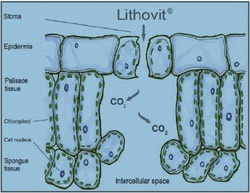Lithovit is a natural mineral (dolomite, limestone) containing mainly CaCO3 (about 80%), Mg CO3 (around 5%) as well as different trace elements (micro nutrients) relevant for plant physiology. It is harmless to humans and animals.
Dolomite is mined and then milled in a special Hightec Nano Mill (rotating up to 20.000 revolutions per minute) to an extremely fine powder with particle size much smaller (< 10 μm) than the stomata pores of the plant leaves. As Lithovit particles are so small, they can be absorbed directly through the stomata of the plant‘s foliage. During the milling process the particles are highly activated by means of the so called tribodynamic activation. Once Lithovit is suspended in water and sprayed onto leaves, the particles penetrate through the stomata into the intercellular compartment and release CO2 with high concentration according to a physicochemical reaction at the cell membrane. CO2 diffuses into the cell and enhances the photosynthesis.
Dolomite is mined and then milled in a special Hightec Nano Mill (rotating up to 20.000 revolutions per minute) to an extremely fine powder with particle size much smaller (< 10 μm) than the stomata pores of the plant leaves. As Lithovit particles are so small, they can be absorbed directly through the stomata of the plant‘s foliage. During the milling process the particles are highly activated by means of the so called tribodynamic activation. Once Lithovit is suspended in water and sprayed onto leaves, the particles penetrate through the stomata into the intercellular compartment and release CO2 with high concentration according to a physicochemical reaction at the cell membrane. CO2 diffuses into the cell and enhances the photosynthesis.
Mechanism

Inside the leaves, the Lithovit® particles break down and release CO2 in particular, but also other substances as well.
The Lithovit particles that penetrate into the intercellular compartment dock with their negatively-charged surface on the outside of the cell membrane and induce a negative potential which attracts the positive hydrogen ions formed in the first step of the photosynthesis through the membrane to outside.
These dock on the carbonate groups of the Lithovit particles forming carbonic acid which decomposes to carbon dioxide and water.
Not all Lithovit particles penetrate at once through the stomata. A big part of them remains on the leaves
surface and penetrate frequently when they get wet at night by dew.
Mechanism is based on the thermodynamic equilibrium:
(Ca,Mg)CO3 + H2O + CO2 <------> (Ca, Mg)(HCO3)2
The Lithovit takes CO2 from the atmosphere in the night (as well as from plant breathing) and H2O from dew and is converted to hydrogen carbonate.
During the day the temperature increases, the water evaporates out of the equilibrium which therefore shifts tothe left hand side forming back the Lithovit (carbonate form) and setting CO2 at high concentration right at the leaf surface that diffuses instantaneously through the stomata. Lithovit is thus acting as long term depot supplying plants with CO2 (over long time).
- Prof. Dr. Abdel-Latif Bilal
The Lithovit particles that penetrate into the intercellular compartment dock with their negatively-charged surface on the outside of the cell membrane and induce a negative potential which attracts the positive hydrogen ions formed in the first step of the photosynthesis through the membrane to outside.
These dock on the carbonate groups of the Lithovit particles forming carbonic acid which decomposes to carbon dioxide and water.
Not all Lithovit particles penetrate at once through the stomata. A big part of them remains on the leaves
surface and penetrate frequently when they get wet at night by dew.
Mechanism is based on the thermodynamic equilibrium:
(Ca,Mg)CO3 + H2O + CO2 <------> (Ca, Mg)(HCO3)2
The Lithovit takes CO2 from the atmosphere in the night (as well as from plant breathing) and H2O from dew and is converted to hydrogen carbonate.
During the day the temperature increases, the water evaporates out of the equilibrium which therefore shifts tothe left hand side forming back the Lithovit (carbonate form) and setting CO2 at high concentration right at the leaf surface that diffuses instantaneously through the stomata. Lithovit is thus acting as long term depot supplying plants with CO2 (over long time).
- Prof. Dr. Abdel-Latif Bilal
